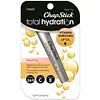What's inside
What's inside
 Key Ingredients
Key Ingredients

 Benefits
Benefits

 Concerns
Concerns

 Ingredients Side-by-side
Ingredients Side-by-side

Capryloyl Glycerin/Sebacic Acid Copolymer
Skin ConditioningRicinus Communis Seed Oil
MaskingHelianthus Annuus Seed Oil
EmollientC13-15 Alkane
SolventCera Alba
EmollientLimnanthes Alba Seed Oil
Skin ConditioningCocos Nucifera Oil
MaskingAroma
Silica
AbrasivePassiflora Edulis Seed Oil
EmollientButyrospermum Parkii Butter
Skin ConditioningTocopherol
AntioxidantCitric Acid
BufferingGlyceryl Behenate
EmollientCitral
PerfumingHexyl Cinnamal
PerfumingHydroxycitronellal
PerfumingLimonene
PerfumingCapryloyl Glycerin/Sebacic Acid Copolymer, Ricinus Communis Seed Oil, Helianthus Annuus Seed Oil, C13-15 Alkane, Cera Alba, Limnanthes Alba Seed Oil, Cocos Nucifera Oil, Aroma, Silica, Passiflora Edulis Seed Oil, Butyrospermum Parkii Butter, Tocopherol, Citric Acid, Glyceryl Behenate, Citral, Hexyl Cinnamal, Hydroxycitronellal, Limonene
Octyldodecanol
EmollientRicinus Communis Seed Oil
MaskingEthylcellulose
Caprylic/Capric Triglyceride
MaskingPhenoxyethanol
PreservativePolyglyceryl-3 Diisostearate
EmulsifyingAroma
Linum Usitatissimum Seed Oil
PerfumingOlea Europaea Fruit Oil
MaskingRibes Nigrum Seed Oil
EmollientHelianthus Annuus Seed Oil
EmollientTocopherol
AntioxidantEthylhexylglycerin
Skin ConditioningAscorbyl Palmitate
AntioxidantWater
Skin ConditioningGlycine Soja Oil
EmollientBixa Orellana Seed Oil
EmollientCitrus Grandis Peel Extract
AstringentOctyldodecanol, Ricinus Communis Seed Oil, Ethylcellulose, Caprylic/Capric Triglyceride, Phenoxyethanol, Polyglyceryl-3 Diisostearate, Aroma, Linum Usitatissimum Seed Oil, Olea Europaea Fruit Oil, Ribes Nigrum Seed Oil, Helianthus Annuus Seed Oil, Tocopherol, Ethylhexylglycerin, Ascorbyl Palmitate, Water, Glycine Soja Oil, Bixa Orellana Seed Oil, Citrus Grandis Peel Extract
Ingredients Explained
These ingredients are found in both products.
Ingredients higher up in an ingredient list are typically present in a larger amount.
Aroma refers to an ingredient, or mixture of ingredients, that impart or mask a flavor.
The name is slightly confusing. This is because INCI associates aroma with flavor instead of smell.
Here is the official definition from the The International Cosmetic Ingredient Dictionary and Handbook:
“Aroma is a term for ingredient labeling used to identify that a product contains a material or combination of materials normally added to a cosmetic to produce or to mask a particular flavor.”
INCI shows the only purpose of aroma to be "flavouring".
However, due to regulation differences, some companies may use aroma in place of parfum.
In Canada, this ingredient only has to be listed in concentrations above 1%.
Learn more about AromaHelianthus Annuus Seed Oil is the oil derived from the seeds of a Sunflower. Sunflower seed oil is non-fragrant. It is an emollient, meaning it helps to soften the skin.
Sunflower seed oil contains many fatty acids. The fatty acids found in sunflower seeds include (from highest amount to least): linoleic acid, myristic acid, palmitic acid, stearic acid, arachidic acid, oleic acid, and linolenic acid.
These fatty acids help the skin create ceramides. Ceramides play a role in repairing the skin barrier.
Helianthus Annuus Seed Oil helps moisturize the skin. This in turn helps the skin look more rejuvenated and smoother.
Sunflowers are rich in vitamin E.
Historians believe Indigenous cultures of North America domesticated sunflowers before corn. Thus they relied on sunflower oil for a variety of uses. One such use is moisturizing skin and hair.
Sunflower seed oil may not be fungal acne safe. We recommend speaking with a professional if you have any concerns.
Learn more about Helianthus Annuus Seed OilRicinus Communis Seed Oil is the INCI name for castor oil.
Castor Oil helps moisturize the skin. It is rich in a fatty acid called ricinoleic acid. This fatty acid helps prevent moisture loss on the skin. This helps keep your skin soft and hydrated. Ricinoleic acid also has anti-inflammatory and pain reducing properties.
Besides hydrating the skin, castor oil is also used to hydrate hair. By keeping the hair shaft moisturized, breakage is decreased. More studies are needed to show castor oil's effective on stimulating hair growth.
Castor oil is created by cold-pressing castor seeds and then purifying the oil with heat. It was used in Ancient Egypt as fuel in lamps and to help treat eye irritation.
The term 'fragrance' is not regulated in many countries. In many cases, it is up to the brand to define this term. For instance, many brands choose to label themselves as "fragrance-free" because they are not using synthetic fragrances. However, their products may still contain ingredients such as essential oils that are considered a fragrance.
Learn more about Ricinus Communis Seed OilTocopherol (also known as Vitamin E) is a common antioxidant used to help protect the skin from free-radicals and strengthen the skin barrier. It's also fat soluble - this means our skin is great at absorbing it.
Vitamin E also helps keep your natural skin lipids healthy. Your lipid skin barrier naturally consists of lipids, ceramides, and fatty acids. Vitamin E offers extra protection for your skin’s lipid barrier, keeping your skin healthy and nourished.
Another benefit is a bit of UV protection. Vitamin E helps reduce the damage caused by UVB rays. (It should not replace your sunscreen). Combining it with Vitamin C can decrease sunburned cells and hyperpigmentation after UV exposure.
You might have noticed Vitamin E + C often paired together. This is because it is great at stabilizing Vitamin C. Using the two together helps increase the effectiveness of both ingredients.
There are often claims that Vitamin E can reduce/prevent scarring, but these claims haven't been confirmed by scientific research.
Learn more about Tocopherol